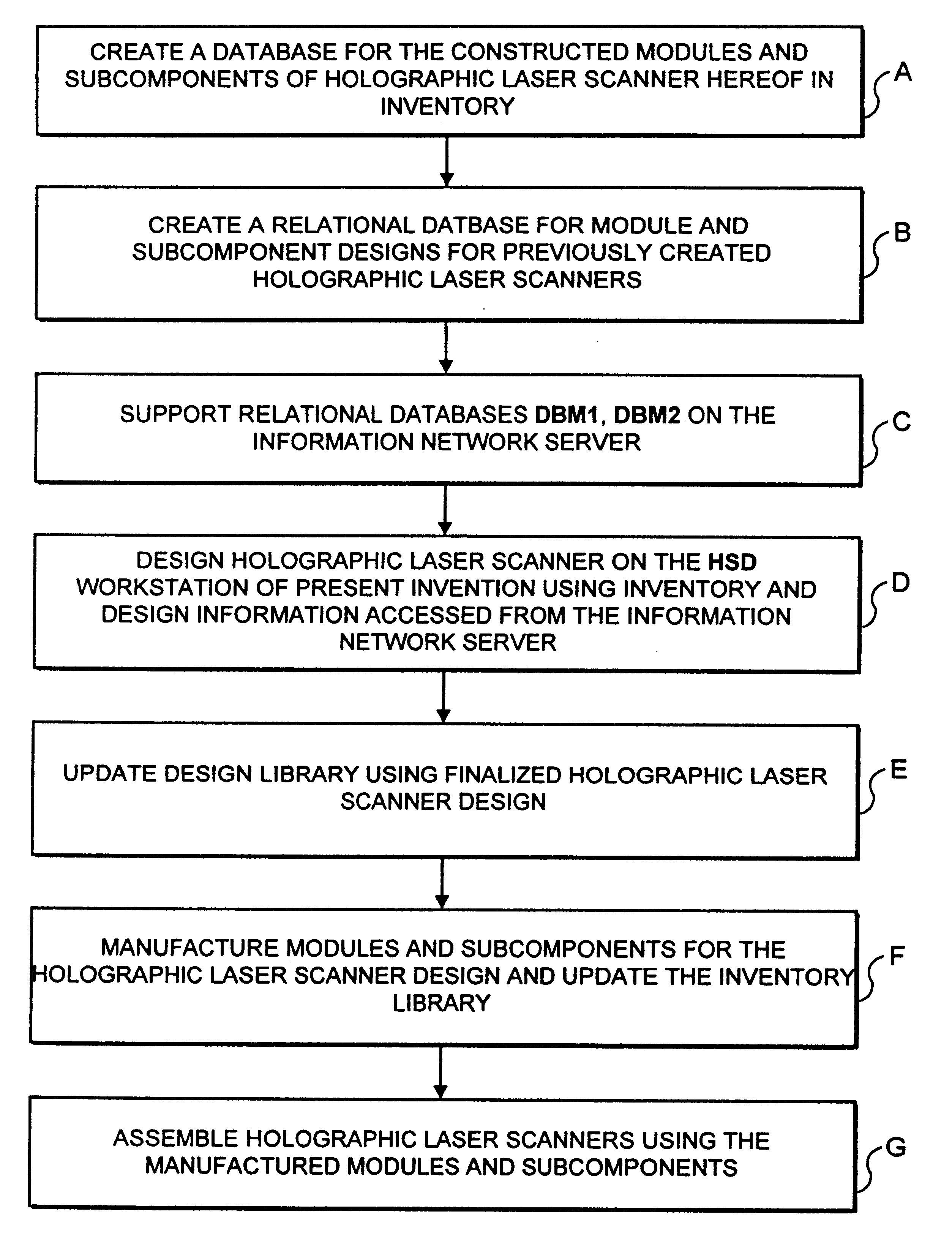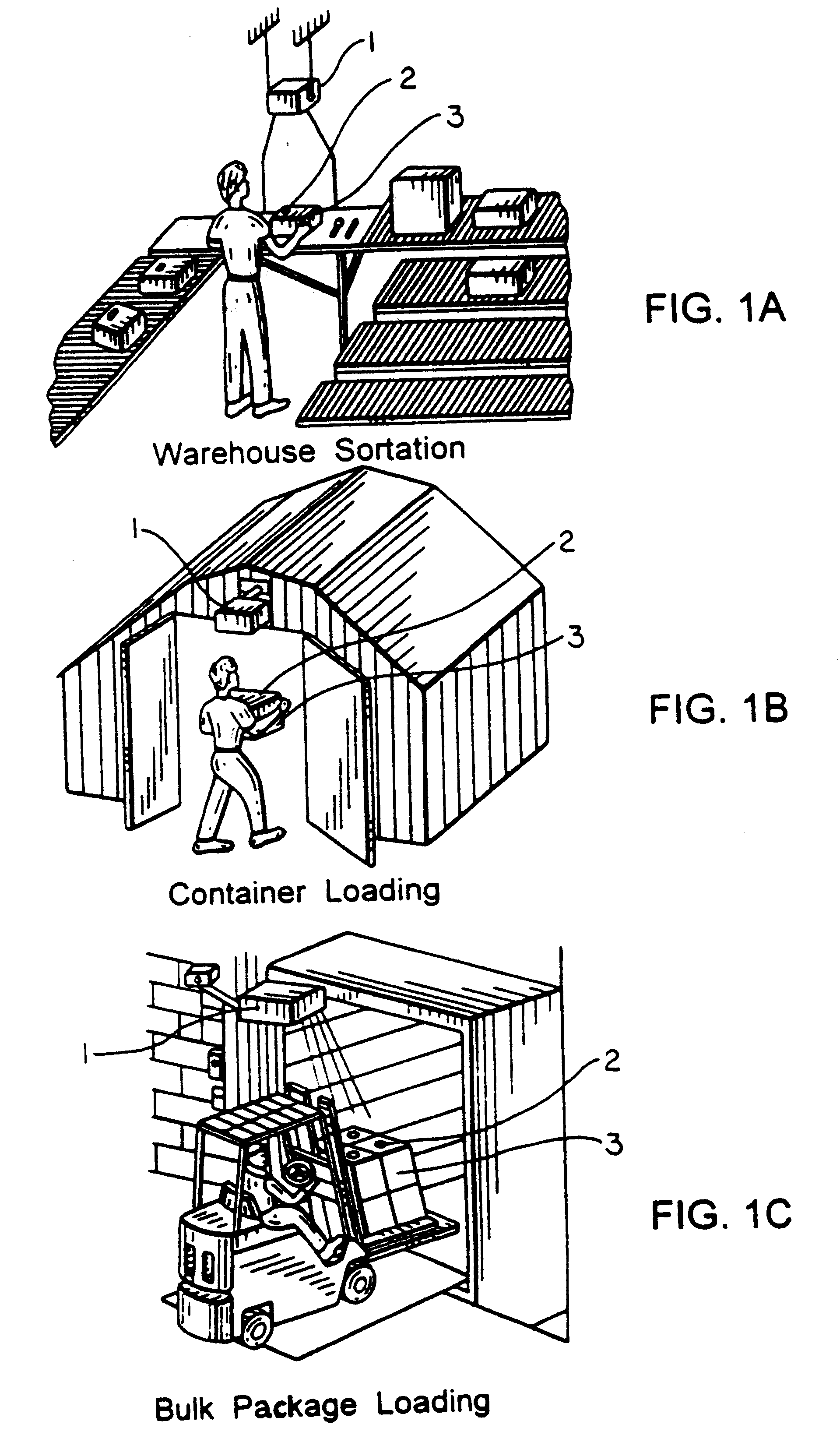While prior art holographic scanning systems have many advantages over mirror-based
laser scanning systems, prior art holographic scanners are not without problems.
In the first holographic
scanner produced by International Business Machines (IBM), the holographic facets on its holographic disc were simple sectors which did not allow for independent control over light collection and
light scanning functions.
However, the holographic discs employed in prior art holographic scanners, e.g., the HOLOSCAN 2100.TM. holographic laser
scanner designed and sold by Holoscan, Inc. of San Jose, Calif., fail to (i) maximize the use of available space on the disc for light collection purposes, and (ii) minimize the
scan line speed for particular
laser scanning patterns.
As a result of such design limitations, prior art holographic scanners have required the use of large scanning discs which make inefficient use of the
available light collecting surface area thereof.
They also are incapable of producing from each holographic
facet thereon, detected scan data signals having substantially the same
signal level independent of the location in the scanning volume from which the corresponding optical scan
data signal is produced.
Consequently, this has placed great demands on the electrical
signal processing circuitry required to
handle the dramatic
signal swings associated with such detected return signals.
While U.S. Pat. No. 4,415,224 to Applicant (Dickson) discloses a method of equalizing the light collection efficiency of each
facet on the holographic scanning disc, it does not disclose, teach or suggest a method of equalizing the light collection efficiency of each
facet on the holographic scanning disc, while utilizing substantially all of the light collecting surface area thereof.
However, due to limitations of conventional design principles, it has not been possible to build prior art holographic scanners having sufficient compactness required in many applications.
Consequently, the huge housings required to enclose the optical apparatus of prior art holographic laser scanners have restricted their use to only a few practical applications where housing size constraints are of little concern.
While highly desirable because of their low
power usage and miniature size,
solid-state
visible laser diodes (VLDs) cannot be used practically in prior art holographic laser scanners because of several problems which arise from inherent properties of conventional VLDs.
The first problem associated with the use of VLDs in holographic laser scanners is that the VLDs do not produce a single
spectral line output in the manner of conventional He--Ne2 laser tubes.
Both of these characteristics of VLDs result in a spreading of the laser beam as it leaves the highly dispersive holographic facet of the holographic disc.
This results in an effectively larger "spot" at the focal point of the holographic facet, causing errors in the resolution of the bars and spaces of scanned code symbols and, often, intolerable
symbol decoding errors.
The second problem associated with the use of VLDs in a holographic scanner is that the inherent "astigmatic difference" in VLDs results in the production of
laser beams exhibiting
astigmatism along the
horizontal and vertical directions of propagation.
Thus, at particular points in the scanning field of a holographic scanner using a VLD, the orientation of the laser beam ("flying spot") will be such that the bars and spaces cannot be resolved for
symbol decoding operations.
Holographic scanners suffer from other technical problems as well.
In prior art holographic scanners, the light collection and detection
optics are necessarily complicated and require a significant volume of space within the scanner housing.
This necessarily causes the height dimension of the scanner housing to be significantly larger than desired in nearly all code symbol reading applications.
Consequently, it has been virtually impossible to design a holographic laser scanner with a three-dimensional scanning volume that is capable of scanning bar code symbols independent of their orientation as they move through the scanning volume.
Because of the methods used to design and construct prior art holographic disks, the size and shape of the light collection area of each facet could not be controlled independent of the angular sweep of the outgoing laser beam.
Consequently, this has prevented optimal use of the disk surface area for light collection functions, and thus the performance of prior art holographic scanners has been necessarily compromised.
While the above problems generally define the major areas in which significant improvement is required of prior art holographic laser scanners, there are still other problems which have operated to degrade the performance of such
laser scanning systems.
In particular, glare produced by
specular reflection of a laser
beam scanning a code symbol reduces the detectable contrast of the bars and spaces of the symbol against its background and thus the SNR of the optical scan
data signal detected at the photodetectors of the
system.
While polarization filtering techniques are generally known for addressing such problems in
laser scanning systems, it is not known how such techniques might be successfully applied to holographic type laser scanning systems while simultaneously solving the above-described problems.
 Login to View More
Login to View More  Login to View More
Login to View More 


